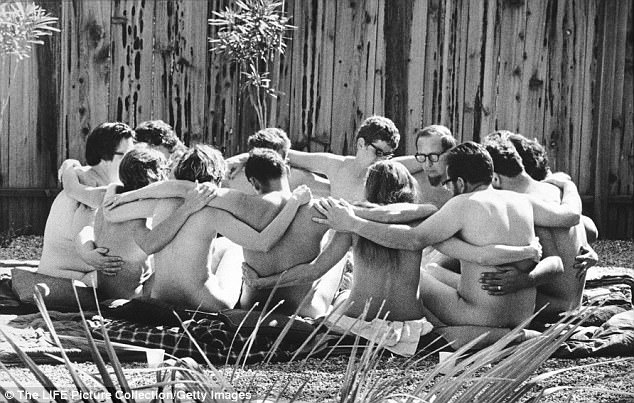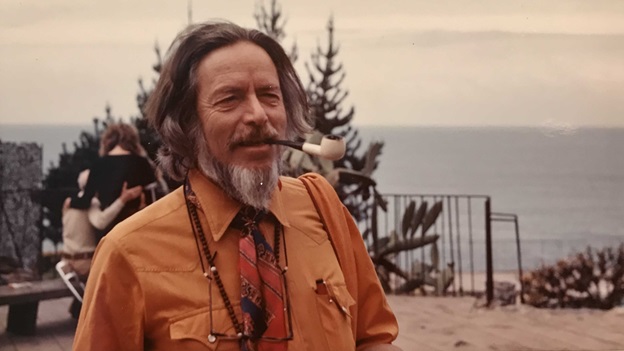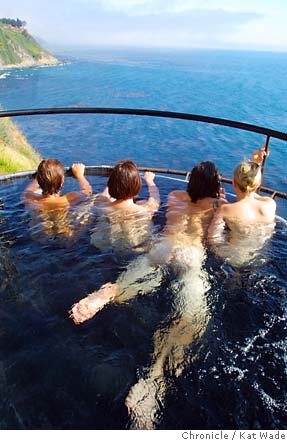One of the highlights of my September 2018 trip to California was the chance to meet Michael Murphy. With his friend Dick Price, Mike co-founded the Esalen Institute, a cross between an adult education college and a spiritual retreat centre on the cliffs of Big Sur. Esalen is the spiritual home of transpersonal psychology, where psychologists like Abraham Maslow, Stanislaf Grof, and Fritz Perls developed their ideas. So many contemporary practices and ideas – from holotropic breathwork to ecstatic dance to somatic therapy to Authentic Relating to the idea of ‘spiritual emergencies’ – were born in that cultural incubator.

It is still going, 57 years later, which is a remarkable feat when you think how quickly and spectacularly other spiritual experiments went wrong. Mike Murphy is still going too – at 88, he is a picture of good vibes, with an incredibly well-stocked memory, bags of energy and a remarkable generosity of spirit (we spoke for three hours). I met him to discuss the so-called ‘mystical expatriates’ – Aldous Huxley, Gerald Heard, Alan Watts and Christopher Isherwood – who all moved from England to the US in the 1930s, settled in California, and helped inspire contemporary spirituality. Watts and Huxley in particular are modern prophets, and it’s amazing to meet someone who was friends with them, worked with them, and developed their ideas so influentially. It’s also fascinating to learn from Murphy what he thinks made Esalen such an enduring success – no guru, no religion, an emphasis on quality of teachers, and a balance between the aesthetic Apollonian and the messy Dionysiac elements.
You’re one of the few people who knew all four of the ‘mystical expats’ and who was very influenced by them, and friends with them.
Isherwood I didn’t know so well, but I’m deeply fond of the three I knew. They all came to the States before the War. None of them seemed to have any guilt about fleeing and getting out of harm’s way, and I can’t see Heard or Huxley in the British military. All four of these guys were full of life, and not crippled by footnotes in their writing, but still deeply informed, with great judgement and intuitive vision. People asked William James if he was a mystic and he said ‘I wouldn’t call myself a mystic but I have a substantial mystic germ’. Each of your four had a strong mystical germ though they weren’t practicing contemplatives.
Who did you encounter first?
Alan Watts. I encountered him through Frederic Spiegelberg and the American Academy of Asian Studies [which later became the California Institute of Integral Studies]. Spiegelberg was a lecturer at Stanford University in comparative religion, probably the greatest lecturer I ever heard. I stumbled into his class by mistake at Stanford in 1950. In 1951 he recruited students on the Stanford Campus for the new Academy of Asian Studies, and he claims I was the first to sign up. I took a quarter off at the end of my junior year and took the train up to San Francisco to attend classes there. Alan had moved West and was a full-time teacher at the Academy. He, Spiegelberg and Haridas Chaudhuri would do symposia there and became hot items in the City during the blossoming of the San Francisco renaissance..
There was an Indian renaissance at the end of the 19th century, mainly based in Bengal and led in large part by religious innovators such as Vivekananda, Ramakrishna, Rabindranath Tagore, and Sri Aurobindo. Influenced by Spiegelberg I was inspired especially by Sri Aurobindo and his ideas on evolutionary spirituality. Spiegelberg had experienced darshan with both Sri Aurobindo and Ramana Maharshi, and he helped transmit that spark of the Bengali renaissance into the San Francisco renaissance – as did Alan, Huxley, Isherwood and Heard.
[That’s a very interesting point, by the way. Part of the Bengali renaissance was the idea of the Perennial Philosophy – the idea there is a common core found within the great religions, particularly in their mystical teachings. Vivekananda and others helped to preach that in the Bengal Renaissance, and then Huxley, Watts and others helped to transmit that idea into the San Francisco Renaisance and the Sixties counter-culture. It’s interesting to note how often the Perennial Philosophy is found within eras of cultural flourishing called ‘renaissances’ or Golden Ages.]
Spiegelberg was more than just a scholar. He had genuine mystical insight. You know, it’s very hard to measure the degree of mystical realization in a person. But I think I was close enough to Watts, Huxley and Heard to make a guess. Alan was never a disciplined meditator, and he did have a drinking problem at the end of his life, but he often spoke as one who knew.
What was Watts like?
Alan was a huge influence on Bay Area culture because he was so insightful, funny and witty. But not saracastic. He was generous and very playful. His weaknesses were on the side of impulse control, not on the side of cruelty snark. He was fun and he was brilliant. Aesthetics were huge for Alan – he could have been a professor of aesthetics like John Ruskin. He was a great appreciator of beauty – costume, cooking, architecture, Feng Shui, clothes, costumes, poetry.
So his influence was feeding out into the Renaissance, into the music of John Cage and so on.
Yes. Anyway, by 1962 Dick Price and I were launching Esalen on a property in Big Sur my grandfather had bought in 1910. Along the way, Alan had wanted to buy a house there. The first lecture that happened at the site after Dick and I took it over was by Alan and when Esalen got fully underway he was a principal participant. And we used his mailing list to advertise our first seminars.
Tell me about Gerald Heard.
My inspiration to start Esalen arose in large part from the evolutionary thinking of Sri Aurobindo, much of which Heard shared in principle – I call it evolutionary panentheism. It can, I believe, be seen as part of an emerging canon, in league with the German Idealists, Henri Bergson, Teillard de Chardin, Alfred Whitehead and Aurobindo. That’s how I encountered Heard before hearing Huxley’s lectures on human potentialities, which he started giving in 1959.
You’ve heard of the Sequioia Seminars? They were run by a Stanford professor, Harry Rathburn and his wife, and attracted the elite of Silicon Valley, before it was so named. I lived in Palo Alto and got to know them and started to hear about Heard through their programs. His influence was spreading through various circles. Gerald was extremely charismatic and became a kind of guru. For example, Clare Booth Luce, the wife of Henry Luce, founder of the Time Life empire, was a super-celebrity in her own right and was taking LSD with Gerald Heard on the site of Esalen.
Anyway, I met Dick Price at Stanford, and he told me about Huxley’s lectures, from which we took a language which helped to frame our brochures for Esalen, the language of ‘human potentialities’. We contacted Huxley, and he suggested we meet Gerald, who had experimented with a spiritual community at Trabuco, near Los Angeles. So Dick Price and I went to see Gerald. He lived in a cottage at Pacific Palisades with his companion, Michael Barrie. After that meeting, it was all go for me when it came to starting Esalen. I would call it a second turning in the way my first lecture with Spiegelberg had been in 1950.
I’m sure he did that for a lot of people. There have been characters like him throughout history. In the Christian tradition, Francis de Salle had huge influence in the courts of France. Or a healthier version of Rasputin. A charismatic influencer. He certainly had the mystic germ. There’s a Sanskrit term, diksha – transmission. A transmission can come through a book, a word, a touch, a look, or from a distance. He transmitted a fire to us.
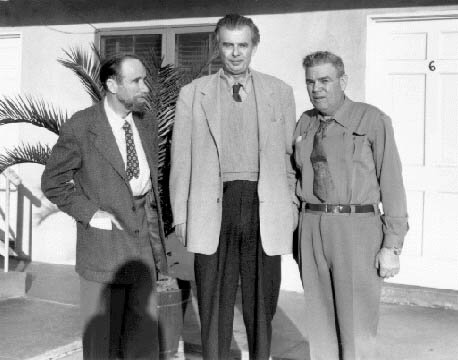
Gerald Heard (left) with Aldous Huxley and Captain Al Hubbard, after one of their 1950s psychedelic sessions. Heard was a big influence on many in his generation, including WH Auden, Christopher Isherwood and Huxley – who he inspired to abandon atheist materialist and explore empirical spirituality in the 1930s.
Heard had obviously tried something similar to Esalen at Trabuco. He wrote about wanting to set up something halfway between a college and a monastery, to learn different spiritual techniques.
That’s why Dick and I went to meet him. Gerald added huge fuel to the fire. And he even gave us a geological reasons for siting the project at Big Sur! He knew about the mountains behind our property, still pushing west. He got into his deep Irish and pretty soon the wee people were appearing – ‘this is a spirit-infested land’ he said. He was a spontaneous bard, and could weave an enchanting spell. He was very Irish and had some pretty wild ideas. We invited him to come up when the programme started, for the first set of lectures in the Fall of 1962. He gave a lecture and then came up again for three weeks. He was there when Huxley died in 63, and gave a vigil for him.
But you didn’t model Esalen on Trabuco?
There were three or four big differences. First, he was the big teacher at Trabuco. We did not want to be an ashram. No gurus, no one captures the flag, an open centre. That was our commitment.
Second, Trabuco was sort of a commune, with permanent residents. We didn’t want to be a commune. That’s been a long struggle for decades – is it a commune or not. We had 100 people on our staff, and people coming from all over the world. We didn’t want to franchise it either – by 1969 there were 100 centres modelled on Esalen.
Third, we were very much in the California culture which wasn’t as conflicted about sex as Gerald seemed to be. He claimed he was celibate, which I am willing to believe. Gerald was a peculiar mixture of wild and inhibited. Wild in his ideas and inhibited in his (homo) sexuality. We didn’t suffer from that, and we had those baths. They were segregated by gender initially but finally we had joint bathing. What’s the big deal? Alan was right in the middle of it. He embraced sex rather than asceticism.
Fourth, we were much bigger. Now, 15,000 people a year come through it.
And finally, we’ve been going 57 years, whereas Trabuco only lasted a few. Gerald was not temperamentally suited to run an organisation. He didn’t have a lot of tolerance for interpersonal ambiguity. He didn’t have the patience. He was a flaming meteor and turned a lot of people, a hugely catalytic figure who did not leave an enduring canon in his writing, as Huxley did. One still reads Huxley’s books, unlike Gerald’s. His influence has melted into history, but it was very important. Only a few are selected by historians to last in our memory. 90% of history melts away. But it’s good to remember what actually did happen. Gerald was a significant part of our history.
Esalen has a different funding model too – paying for short intense courses, which is a very influential model now at retreat centres.
That’s how universities started – Hegel and the great German professors got paid for how many students turned up. That’s how Esalen started too. We were a non-profit, but we charged. And we got grants, right from the beginning. Gerald never aspired to that. For example, I got the Ford Foundation together with Professor George Brown of UC Santa Barbara to research educational methods. That led to the department of confluent education at UC Santa Barbara, which resulted in 500 graduate degrees and a new curricula for schools from kindergarten through the 12th grade.
We were brokers, like a venture capital firm for individuals and research programmes. That was way beyond what Heard was doing. We did it with medicine too. The first legislation on holistic health in the US was written by the Esalen staff. We’ve run invitational conferences on psychology, medicine, diplomacy, religion. We have similarities with Silicon Valley. There’s more freedom for all this out here than there is in most other places. We have a regional advantage, one might say. We’re more mobile intellectually and spiritually. Part of that is the Californian culture.
Let’s talk about Aldous Huxley. He was an influence on the early vision of Esalen through his lectures on human potentiality. Did you meet him?
Yes. When I met him, in the summer of 1962, I was hugely nervous. I was just starting Esalen, I was 31. I was still a virgin. I had met famous people growing up, but still, having read him, I was awestruck. I was an enormous fan, having read After Many A Summer, Time Must Have A Stop, Brave New World, his essays, Doors of Perception, and much else. He was a grand figure, a celebrity.
Did you read Huxley’s last novel, Island?
Yes. He was writing that when we met.
He was a grand figure, but accessible – you just wrote to him and he came.
Well, there I was in a broken-down motel at the end of nowhere, but he like many others joined us. Arnold Toynbee came – I sent him $100 for the travel. It was the flag we raised, and how I explained the vision in my letters. George Leonard said ‘boy, you know how to seduce people with these letters’. I hadn’t written anything at that point.
Huxley…well, I fell in love with him. He’d heard about our butterfly trees and wanted to see them. He walked along with these huge loping steps. We fell into this easy repartee, and had an easy conversation. He and Laura stayed overnight. This was just after his house had burned down, so they were thinking of moving nearby. He was a great conversationalist, different from Gerald, who was much more animated and intense. Aldous was cool, highly cultivated. Think about his family – Matthew Arnold on one side, Thomas Huxley on the other, talk about to the manner-born!
He was no hippy, in the way that Watts was.
Not at all. Aldous had huge tolerance of ambiguity though. He was no snob when it came to sex or anything, it seemed. But he wouldn’t have been doing any of the movement exercises, and he was used to politeness and good form. I can’t see him in an encounter group – first of all, he couldn’t see well enough to see across a room. I can’t remember if he went to the baths or not. And he made helpful suggestions for us. He made us aware of Gestalt therapy, and of somatic awareness, and the ‘non-verbal humanities’.
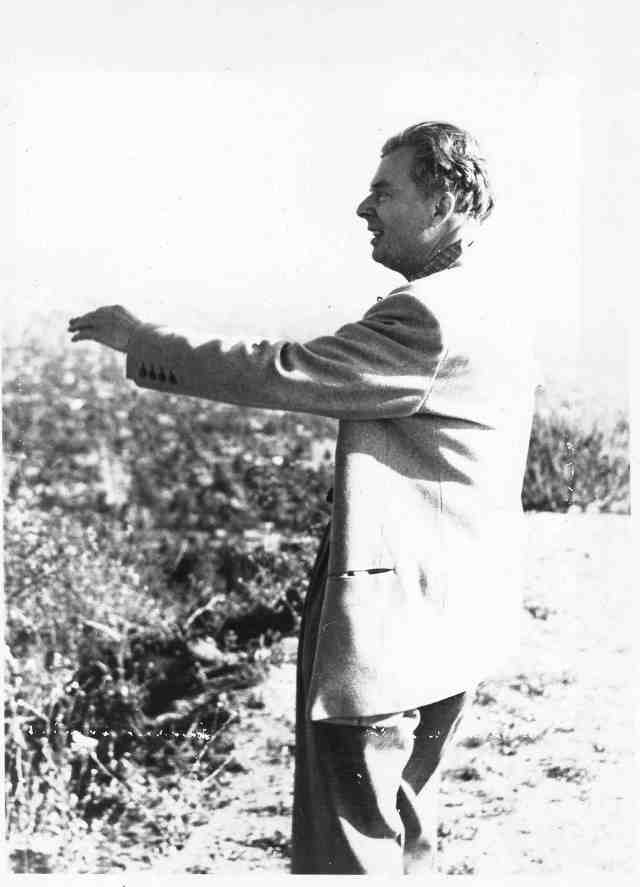
A photo taken of Huxley on his first mescaline trip, looking out over Los Angeles. The photo was taken by the psychiatrist Humphrey Osmond, who later coined the word ‘psychedelic’
He was very into the idea of physical training, despite being this rather gangly, half-blind intellectual.
He was never destined to be an athlete. He was six foot four, and walked with these loping steps. He was already 68 when we met. He said a number of things to us that were kind of prophetic. He said words to the effect of ‘one of your challenges will be the conflict in you and your guys between your aesthetic and critical judgement on one side, and your compassion on the other. You are going to have to get your hands dirty.’ And boy has that been true.
Tell me more about that.
Well, it’s things that are not respectable. And things that are on the edge of not working. At Esalen, by 1970, we were resolutely confessing our sins in public – don’t do this, don’t do that. I mean…Tim Leary was wrong – the idea you can take LSD every Sunday. Now there’s a whole return of psychedelics. But it’s not like Tim Leary and everybody stoned every day.
So Huxley was talking about getting your hands dirty, because you’re working with the subconscious. Human development is messy.
Yes.
And it was an ecstatic model of education, so stuff is going to come up.
Right. Managing the unconscious, the Id. If you’re going to do group work, you have to work with what emerges. And we’ve learned certain things don’t work.
Freud and Jung were doing one-on-one therapy. You helped create the model of week-long deep-dive group courses in self-exploration.
Yes. It was very much in the air. But people working at Esalen helped to invent it – Fritz Perls developed his approach at Esalen. Stan Grof invented holotropic breathwork there. Huxley said you have to have both sides – you need to keep your critical judgement and your aesthetic sensibility. He was out of an upper class academic family. You get good manners, aesthetic judgement. And here’s this messiness, looking at it, accepting it. It’s not good form.
And it’s sometimes dangerous. We had a split at Esalen, we called it the Dionysians and the Apollonians. I moved up to the city in 1967 to start a centre in San Francisco. My closest friends, crystallizing around me, were more Apollonian. We were doing events at Grace Cathedral. At Big Sur it got wilder and wilder. It led to conflicts. We used to groan when we heard about some of the stuff happening at Big Sur. Free love was in the air. There were experiments with drugs. With any drug there are limits. So the place had become a living laboratory. The media caught up with this – but they didn’t see a laboratory, they saw a sometimes wild place.
It’s amazing you survived. Think about what happened at Osho’s ashrams at Pune and Oregon.
Dick Price for a while got very enchanted with Osho, then he went over to Pune and he was horrified. They were having encounter groups, and then one discovered he had syphilis and yet slept with seven or eight people. Then Dick watched a wrestling match, and saw a guy get his leg broken. So he flipped and came back lambasting Osho, while Osho started lambasted Dick. Dick gave an interview to Time magazine, so we got caught up – as we did with Scientology – in saying no to these crazier movements. We were exploring, finding our way.
How did you maintain quality control in the Esalen programmes?
For the most part, we’ve conducted public programms (which included professional training seminars) rather than research. The head of programming chooses the leaders. The program is edited all the time, and it starts before anyone comes. That’s how we’ve done it from the start, in 1962. A lot of what we did in the early days came out of psycho-drama – it came out of theatre games and improvisation, like Second City. In those days there was a meeting room next to the dining room. Suddenly there were blood-curdling screams. Eventually a guy came out on all fours, and some people came out and dragged him back in, then more screams. So, to cut a long story short, I told them they couldn’t come back and got a letter from every participant saying ‘Murphy you have no balls at all. You tell us to explore boundaries, then you kick us out’. So we had to use our intuitive judgement and not judge leaders only by what our seminar participants say . Now it’s easier because we hear about programmes before they come to Esalen – it’s like theatre, you get good in smaller theatres before you step up to Broadway. We only accept about a quarter of the leaders who want to do programmes at Esalen.
So, as a group, clearly the mystical expats had a big influence on you. How much on Californian spirituality?
Huge! First, they helped transmit this global lineage, the religion of no religion, experiential comparativism. Not just reading and writing about it, but experiencing it first hand. I would say it’s a global lineage. It comes in large part from the Bengal Renaissance – out of Ramakrishna, Sri Aruobindo, and Vivekananda coming to the US in 1893 and establishing the Vedanta centres, such as the one in Los Angeles where Huxley, Heard and Isherwood practiced.
It’s a lineage in the making that people have given voice to in different ways, particularly Heard and Huxley. They were both very strong on the marriage of science and mysticism, and the importance of depth psychology. They were very influenced by William James and Frederic Myers, as we were at Esalen. We’ve had a 15-year research project on James and Myers.
I love that. I dedicated my last book to Myers because I feel he deserved more credit. He’s barely known in contemporary British psychology or culture.
To add a footnote to perennialism, Jeff Kripal, in his book on Esalen, argues that, mid-century, there was a massive turn from the asceticism of Vedanta to the more full-bodied spirituality of Tantra. Esalen was in the middle of it. You can see it in the difference between Gerald and Aldous. Gerald had a strange relationship to his homosexuality, quite unlike Christopher Isherwood. Jeff Kripal used that story as an example of the move from Vedanta to Tantra in the West at mid-century. Tantra is a vast meta-theory that says the divine is both transcendent and immanent. It’s there in Feng Shui and architecture, in martial arts, in sex. It’s much earthier than much Vedanta and asceticism generally East or West.
In terms of evolutionary spirituality, both Heard and Huxley – like Sri Aurobindo – thought homo sapiens could potentially evolve into a higher spiritual species, and places like Esalen could help catalyse it.
Yes, we could be midwives. This is why I go back to Francis Bacon. He said that science in its basic sense is the acknowledgement that you have to conform your understanding to nature, and not try to get nature fit your understanding. This is the problem with materialist reductionism – it ignores facts like telepathy. I call them supernormalities of everyday life. We started a project years ago on supernormal experience. I’ve believed that we must collect the data of the inner life, like good natural scientists, then get taxonomies, then theories about human nature, in a manner analogous to that process in the physical and biological sciences.
It sounds in the tradition of Frederic Myers and Edward Gurney’s work at the Society of Psychical Research, at the end of the 19th century.
Exactly. I feel in this field we a long way to go. We haven’t done enough natural history. Supernormal capactities are hiding in plain sight, in all sorts of human activity, in the arts, in sport, in every day life. Again and again people have out of the box experiences, but they have no framework or vocabulary for it. My argument is that every human attribute gives rise to supernormal expressions. Myers was onto it – he called it evolutionary buds.
Huxley and Heard had a lot of interest and faith in paranormal research, but it seems like it’s really faded from academic psychology.
It’s almost like Sisyphus – you roll the stone up and it rolls down again. Look at the Society of Psychical Research – it went far ahead of us but now very few people have even heard about it. You need institutions to establish a new scientific paradigm. There are places and programs exploring the edges of our latent supernature but there’s a general resistance to such efforts in mainstream science and academia .
But in other ways, these are good times for transpersonal psychology, no? The boom in contemplation and contemplative science, the renaissance in psychedelic research…
Yes we’ve breached the fort of reductionism. But we’ve got a long way to go.
You could say that such exploration has been helped by Huxley, Heard, and Watts. They were popularizers – bridges between elite spirituality and the masses.
That’s true. They helped drive the democratization of all this, and to some degree an acceptance of it among intellectuals and some scientists.
We have to be careful about thinking scientific spirituality is somehow free from dogma. It’s who controls the power, the funding, the journals, the conferences.
Right – did you read Thomas Kuhn’s book, The Structure of Scientific Revolutions? It’s crucial. Physics is supposed to be free of dogma, but what’s with string theory – there’s no experimental results because they haven’t proposed an experiment. Yet it’s considered a mainstream theory. Lee Smolin argues that seven universities and 32 chairs in academia control theoretical physics. And 29 of those chairs are occupied by string theorists. And there’s a book out, by the historian of science Peter Galison at Harvard – how big science is requiring some things that did not exist before, like ‘trading zones’. At CERN – English is the dominant language, but not everyone speaks English. And not everyone speaks the same theoretical language. In the trading zone you use pidgin languages. That’s pure Esalen. In a sense, Esalen is a trading zone to find a common language for different traditions and experiences.
Esalen has probably paved the way for where we are now – a sort of open-source, de-centered, democratic spirituality. Let’s learn from each other, rather than signing up to one dogma or guru.
Specialization with a single teacher works sometimes, let’s say in music, or in physics. You need specialization, but you also need conversation across boundaries. That’s a regional advantage of Silicon Valley. And Esalen.
What do you think of the rise of national tribalism and the tribalism of identity politics with regard to the Esalen project?
George Leonard started black-white encounter groups at Esalen in 1967. We did that for a few years. We did one recently between Democrats and Republicans. But our main thrust in this regard has been through work on US-Russia relations and Arab-Jewish relations. We organizied a conference in Russia, working with Russian and American students. The theme was ‘who do you trust?’ Why can’t we talk together like these kids did? We want to cultivate the impulse to talk across divides and not be afraid to be messy, and to have faith that there’s a common ground of goodness. Our first black-white encounter groups – black-white encounter as transcendental experience, it was called. There were black folks who’d never had a white friend and white folks who’d never had a black friend. We have Democrat friends who won’t let their daughters go out with Republican men. Can you believe it?
It sounds quite Quaker, what you’re doing.
Quakers are kissing cousins.The contemplation, the good works. I love them.
Is there a left bias among the people at Esalen?
Yes, but we have many conservatives—and even Republicans!—among our leaders and seminarians. And we get criticized from both the left and right!
Esalen is still very much in the news. Here’s an Economist article from November 2019 on how Esalen helped take the counter-culture mainstream. Here’s a New Yorker article from April 2019 on how Esalen is now part of the Silicon Valley ecosystem and is trying to help tech CEOs find their conscience. And here’s an extraordinary excerpt from a new book on how Murphy researched superhuman powers, or ‘sidhis’ in sport and advised the US government on mind control. For more on the mystical expatriates, here’s an article I wrote. A shout out to QMUL colleague Jake Poller for his excellent new book on Aldous Huxley and Alternative Spirituality.
And if you want a taste of an Esalen seminar from the heady days of 1968, here’s one featuring Alan Watts, Allen Ginsberg, Claudio Naranjo (a pioneer of psychedelic therapy) and John Weir Perry (a pioneer of work on treating spiritual emergencies), talking about poetry and madness.

